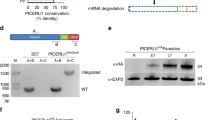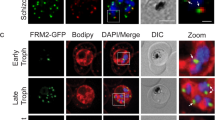Abstract
Malaria transmission is dependent on the development of sexual forms of Plasmodium falciparum, called gametocytes, in the vertebrate host. Pfg27 is an abundantly expressed sexual stage–specific protein that is essential for gametocytogenesis in P. falciparum. We describe the crystal structure of Pfg27, which reveals a novel fold composed of two pseudo dyad–related repeats of the helix-turn-helix motif. Structurally equivalent helices of each repeat either form a dimer interface or interact with RNA in vitro. One side of the dimer presents an unprecedented juxtaposition of four polyproline (PXXP) motifs. Preliminary binding data indicate that these sites are capable of binding Src homology-3 (SH3) modules. Molecular modeling suggests that the dimer can accommodate two SH3 modules simultaneously, potentially enabling molecular crosstalk between SH3-containing proteins. The structural and initial biochemical evidence suggests that Pfg27 may serve as a platform for RNA and SH3 binding.
This is a preview of subscription content, access via your institution
Access options
Subscribe to this journal
Receive 12 print issues and online access
$189.00 per year
only $15.75 per issue
Buy this article
- Purchase on Springer Link
- Instant access to full article PDF
Prices may be subject to local taxes which are calculated during checkout




Similar content being viewed by others
References
Miller, L.H., Good, M.F. & Milon, G. Malaria pathogenesis. Science 264, 1878–1883 (1994).
Breman, J.G. The ears of the hippopotamus: manifestations, determinants, and estimates of the malaria burden. Am. J. Trop. Med. Hyg. 64, 1–11 (2001).
Dearsly, A.L., Sinden, R.E. & Self, I.A. Sexual development in malarial parasites: gametocyte production, fertility and infectivity to the mosquito vector. Parasitology 100 Pt 3, 359–368 (1990).
Carter, R. et al. Plasmodium falciparum: an abundant stage-specific protein expressed during early gametocyte development. Exp. Parasitol. 69, 140–149 (1989).
Lobo, C.A., Fujioka, H., Aikawa, M. & Kumar, N. Disruption of the Pfg27 locus by homologous recombination leads to loss of the sexual phenotype in P. falciparum. Mol. Cell 3, 793–798 (1999).
Alano, P., Premawansa, S., Bruce, M.C. & Carter, R. A stage specific gene expressed at the onset of gametocytogenesis in Plasmodium falciparum. Mol. Biochem. Parasitol. 46, 81–88 (1991).
Alano, P., Silvestrini, F. & Roca, L. Structure and polymorphism of the upstream region of the pfg27/25 gene, transcriptionally regulated in gametocytogenesis of Plasmodium falciparum. Mol. Biochem. Parasitol. 79, 207–217 (1996).
Lal, A.A., Goldman, I.F., Collins, W.E. & Kumar, N. Sequence of a 27-kilodalton gamete antigen of Plasmodium reichenowi and comparison with Pfg27 of Plasmodium falciparum. Mol. Biochem. Parasitol. 59, 175–176 (1993).
Burd, C.G. & Dreyfuss, G. Conserved structures and diversity of functions of RNA-binding proteins. Science 265, 615–621 (1994).
Nagai, K. RNA-protein complexes. Curr. Opin. Struct. Biol. 6, 53–61 (1996).
Zhang, B. et al. A conserved RNA-binding protein that regulates sexual fates in the C. elegans hermaphrodite germ line. Nature 390, 477–484 (1997).
Okabe, M., Imai, T., Kurusu, M., Hiromi, Y. & Okano, H. Translational repression determines a neuronal potential in Drosophila asymmetric cell division. Nature 411, 94–98 (2001).
Kuriyan, J. & Cowburn, D. Modular peptide recognition domains in eukaryotic signaling. Annu. Rev. Biophys. Biomol. Struct. 26, 259–288 (1997).
Lee, C.H., Cowburn, D. & Kuriyan, J. Peptide recognition mechanisms of eukaryotic signaling modules. Methods Mol. Biol. 84, 3–31 (1998).
Kay, B.K., Williamson, M.P. & Sudol, M. The importance of being proline: the interaction of proline-rich motifs in signaling proteins with their cognate domains. FASEB J. 14, 231–241 (2000).
Mayer, B.J. SH3 domains: complexity in moderation. J. Cell Sci. 114, 1253–1263 (2001).
Feng, S., Kasahara, C., Rickles, R.J. & Schreiber, S.L. Specific interactions outside the proline-rich core of two classes of Src homology 3 ligands. Proc. Natl. Acad. Sci. USA 92, 12408–12415 (1995).
Sparks, A.B. et al. Distinct ligand preferences of Src homology 3 domains from Src, Yes, Abl, Cortactin, p53bp2, PLCγ, Crk, and Grb2. Proc. Natl. Acad. Sci. USA 93, 1540–1544 (1996).
Vernet, C. & Artzt, K. STAR, a gene family involved in signal transduction and activation of RNA. Trends Genet. 13, 479–484 (1997).
Sinden, R.E., Butcher, G.A., Billker, O. & Fleck, S.L. Regulation of infectivity of Plasmodium to the mosquito vector. Adv. Parasitol. 38, 53–117 (1996).
Buckling, A., Ranford-Cartwright, L.C., Miles, A. & Read, A.F. Chloroquine increases Plasmodium falciparum gametocytogenesis in vitro. Parasitology 118, 339–346 (1999).
Nguyen, J.T., Turck, C.W., Cohen, F.E., Zuckermann, R.N. & Lim, W.A. Exploiting the basis of proline recognition by SH3 and WW domains: design of N-substituted inhibitors. Science 282, 2088–2092 (1998).
Nguyen, J.T. et al. Improving SH3 domain ligand selectivity using a non-natural scaffold. Chem. Biol. 7, 463–473 (2000).
Hendrickson, W.A., Horton, J.R. & LeMaster, D.M. Selenomethionyl proteins produced for analysis by multiwavelength anomalous diffraction (MAD): a vehicle for direct determination of three-dimensional structure. EMBO J. 9, 1665–1672 (1990).
Kumar Singh, S., Prasad Sati, S., Kongkasuriyachai, D., Kumar, N. & Sharma, A. Expression, purification, crystallization and preliminary X-ray analysis of the sexual stage-specific protein Pfg27 from Plasmodium falciparum. Acta Crystallogr. D 58, 1868–1870 (2002).
Otwinowski, Z. & Minor, W. Processing of X-ray diffraction data collected in oscillation mode. Methods Enzymol. 176, 307–326 (1997).
Brunger, A.T. et al. Crystallography & NMR system: a new software suite for macromolecular structure determination. Acta Crystallogr. D 54, 905–921 (1998).
Jones, T.A., Zou, J.Y., Cowan, S.W. & Kjeldgaard. Improved methods for binding protein models in electron density maps and the location of errors in these models. Acta Crystallogr. A 47, 110–119 (1991).
Brunger, A.T. The free R value: a novel statistical quantity for assessing the accuracy of crystal structures. Nature 355, 472–474 (1992).
Laskowski, R.A., MacArthur, M.W., Moss, D.S. & Thornton, J.M. PROCHECK: a program to check stereochemical quality of protein structures. J. Appl. Crystallogr. 26, 283–291 (1993).
Madej, T., Gibrat, J.F. & Bryant, S.H. Threading a database of protein cores. Proteins 23, 356–369 (1995).
Kleywegt, G.J. & Jones, T.A. A super position. CCP4/ESF-EACBM Newslett. Prot. Crystallogr. 31, 9–14 (1994).
Esnouf, R.M. An extensively modified version of MolScript that includes greatly enhanced coloring capabilities. J. Mol. Graph. Model. 15, 132–134 (1997).
Merritt, E.A. & Bacon, D.J. Raster3D: photorealistic molecular graphics. Methods Enzymol. 277, 505–524 (1997).
Nicholls, A., Sharp, K.A. & Honig, B. Protein folding and association: insights from the interfacial and thermodynamic properties of hydrocarbons. Proteins 11, 281–296 (1991).
Acknowledgements
We are grateful to D. Stuart (Oxford) for his encouragement throughout this project. We thank the Medical Research Council, UK and the staff of BM14 (ESRF, Grenoble, France) for facilitating data collection. We thank S. Jameel (ICGEB) for providing the GST constructs. We also thank past and present members of ICGEB, C. Chitnis, S. Garman and S. Krishnaswamy for help and suggestions. D.K. provided the clone for overexpression of Pfg27. N.K. is supported by a grant from the National Institutes of Health, and A.S. is funded by an International Wellcome Trust Senior Research Fellowship.
Author information
Authors and Affiliations
Corresponding author
Ethics declarations
Competing interests
The authors declare no competing financial interests.
Rights and permissions
About this article
Cite this article
Sharma, A., Sharma, I., Kogkasuriyachai, D. et al. Structure of a gametocyte protein essential for sexual development in Plasmodium falciparum. Nat Struct Mol Biol 10, 197–203 (2003). https://doi.org/10.1038/nsb899
Received:
Accepted:
Published:
Issue Date:
DOI: https://doi.org/10.1038/nsb899
This article is cited by
-
Biology of Plasmodium falciparum gametocyte sex ratio and implications in malaria parasite transmission
Malaria Journal (2019)
-
Plasmodium pseudo-Tyrosine Kinase-like binds PP1 and SERA5 and is exported to host erythrocytes
Scientific Reports (2019)
-
Regulation of PfEMP1–VAR2CSA translation by a Plasmodium translation-enhancing factor
Nature Microbiology (2017)
-
Specific expression and export of the Plasmodium falciparum Gametocyte EXported Protein-5 marks the gametocyte ring stage
Malaria Journal (2015)
-
Sexual development in Plasmodium parasites: knowing when it's time to commit
Nature Reviews Microbiology (2015)



